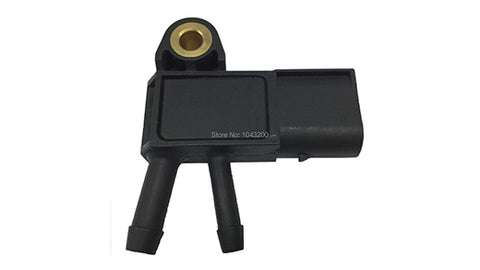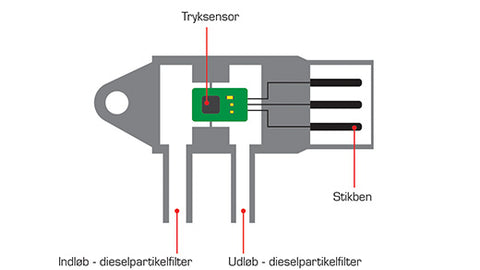How to bypass DPF pressure sensor
Author: SPELAB Mechanical Engineer (focusing on car modification for 10 years)
The power-train control module (PCM) receives a signal from a differential pressure sensor for the diesel particulate filter (DPF) when the filter needs to be cleaned of diesel particulate matter (DPM) or soot. The DPF differential pressure sensor is crucial to the continued proper operation of the DPF. A clogged DPF can badly injure your diesel engine and be very expensive to fix. Let's briefly review the DPF in order to comprehend how the DPF differential pressure sensor functions, why it fails, and how to repair it when it does.
What functions does the DPF differential pressure sensor perform?
Particulate filters sometimes referred to as DPF filters, are a unique kind of exhaust filtration device. Its job is to perform DPF cleaning by eliminating soot and other hazardous environmental particulate matter from engine exhaust gases.
The DPF works on a fairly straightforward principle: the residue left over from the combustion of diesel fuel is sent to a filter that has been carefully chosen, and after passing through it, it settles on the porous walls of the filtering unit. The particles are then automatically afterburn as the temperature of the gases released by the engine rises, allowing the car to virtually entirely remove the emission of soot that is detrimental to human health.
The DPF differential pressure sensor is a different sensor that is necessary for filtration to function effectively. As implied by the name, it is responsible for continuously detecting the pressure difference between exhaust gases before and after the particulate filter. As the pressure rises, the strain gauge that the sensor is built on generates a higher electric voltage.
The car's engine control unit performs the filtering efficiency evaluation by examining the information provided by the DPF differential pressure sensor. Estimating the level of filter filling is also done using the sensor's results. The DPF differential pressure sensor will immediately notify the car's onboard computer that the particle filter needs to be automatically refilled or that it should be changed if the system's effectiveness begins to decline.
How should I respond if the DPF differential pressure sensor malfunctions?
The DPF system is intended to function as a self-healing filtering unit. However, for this to happen, certain circumstances must exist. Soot that has built up in the particulate filter must be periodically burned, which is the fundamental problem with the operation of vehicles with DPF.
If the DPF differential pressure sensor is operating properly, it will communicate data to the vehicle's onboard computer before starting the process of burning out the exhaust filter. As a result, more fuel is used, and the temperature in the particle filter and exhaust system rises dramatically. This enables the nearly full burning of all soot.
Sadly, there are times when the filter system needs to be replaced. In these situations, the DPF differential pressure sensor will alert the driver by displaying an error message on the dashboard of the car. On the contrary, you should visit a DPF delete shop to speak with a specialist and, if the diagnosis calls for it, have a repair done if the engine loses power, produces a lot of smoke, or behaves much differently than usual.
DPF Delete Pros and Cons
Due to the numerous benefits of DPF deletion, the majority of owners of diesel-powered vehicles do not hesitate to ask for a DPF delete kit. However, removing the component is equivalent to having a coin with a tail and a head that has two sides.
In other words, keep in mind the problems that will arise after removing your DPF in addition to the advantages of doing so. Without further do, here are the advantages and disadvantages of DPF deletion.
Pros
- Increased engine horsepower.
- Improved gas mileage.
- Better vehicle acceleration.
- Improved throttle response.
- Reduced exhaust gas temperature.
- Longer service lifespan.
Cons
- Increased exhaust gas and particulate matter release.
- Attracts legal penalties, including fines due to violation of emission law.
- High tendency to fail MOT emissions tests.
- Poses a serious threat to human health.
How to fix a differential pressure sensor in a DPF
When troubleshooting engine sensors, it is advised to start by searching for any indications of obvious damage. Beginning with the electrical connector for the sensor, examine each connection for any signs of damage like melting or breaking. Wires that have been damaged must be replaced.
Next, examine the hoses that are attached to the sensor. Once more, keep an eye out for any damage like melting or cracking. If the hoses are damaged, they must be replaced and very certainly redirected to prevent further damage. Examine the hoses for obstructions or clogs if they appear to be in good physical condition. The hoses must be cleaned or replaced if they are clogged.
The DPF differential pressure sensor can be tested with a multimeter set to 20V and a pressure gauge if everything passes physical inspection.
- Run a fast plausibility test by determining the battery voltage when the engine is off and the battery is plugged into the multimeter. It needs to be close to 12.6 volts.
- Locate the signal, ground, and 5-volt reference by consulting the manufacturer's service manual, then back-probe the wires.
- Switch on the ignition without running the engine. The multimeter should (usually) show a voltage for the 5-volt reference between 4.5 and 5 volts, a constant 0 volts for the ground wire, and a voltage for the signal wire between 0.5 and 4.5 volts. For accurate specifications on your vehicle, refer to OEM factory service literature.
- After back-probing the signal wire, start the engine.
- Rev the engine and check to see if the voltage changes. If not, proceed to use a pressure gauge to test the connecting hoses.
- Detach the sensor's hoses while the engine is still running.
- Check both hoses' pressures using a pressure gauge. Use an exhaust back pressure gauge that measures between 0 and 15 PSI for acceptable precision.
- Recheck the voltage of the signal. A number between the hoses' pressure readings should appear on the voltage display. For instance, if the front hose reads 1 PSI and the back hose reads 1⁄2 PSI, the signal wire voltage should fall somewhere in the middle, around.8 volts.

The DPF differential pressure sensor needs to be changed if there is a significant voltage difference or if the pressure values do not match the voltage reading.









